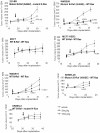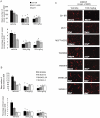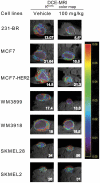The B-Raf status of tumor cells may be a significant determinant of both antitumor and anti-angiogenic effects of pazopanib in xenograft tumor models
- PMID: 21998674
- PMCID: PMC3187787
- DOI: 10.1371/journal.pone.0025625
The B-Raf status of tumor cells may be a significant determinant of both antitumor and anti-angiogenic effects of pazopanib in xenograft tumor models
Abstract
Pazopanib is an FDA approved Vascular Endothelial Growth Factor Receptor inhibitor. We previously reported that it also inhibits tumor cell B-Raf activity in an experimental brain metastatic setting. Here, we determine the effects of different B-Raf genotypes on pazopanib efficacy, in terms of primary tumor growth and anti-angiogenesis. A panel of seven human breast cancer and melanoma cell lines harboring different mutations in the Ras-Raf pathway was implanted orthotopically in mice, and tumor growth, ERK1/2, MEK1/2 and AKT activation, and blood vessel density and permeability were analyzed. Pazopanib was significantly inhibitory to xenografts expressing either exon 11 mutations of B-Raf, or HER2 activated wild type B-Raf; no significant inhibition of a xenograft expressing the common V600E B-Raf mutation was observed. Decreased pMEK staining in the responsive tumors confirmed that B-Raf was targeted by pazopanib. Interestingly, pazopanib inhibition of tumor cell B-Raf also correlated with its anti-angiogenic activity, as quantified by vessel density and area. In conclusion, using pazopanib, tumor B-Raf status was identified as a significant determinant of both tumor growth and angiogenesis.
Conflict of interest statement
Figures






Similar articles
-
Pazopanib reveals a role for tumor cell B-Raf in the prevention of HER2+ breast cancer brain metastasis.Clin Cancer Res. 2011 Jan 1;17(1):142-53. doi: 10.1158/1078-0432.CCR-10-1603. Epub 2010 Nov 16. Clin Cancer Res. 2011. PMID: 21081656 Free PMC article.
-
Bridging the gap between cytotoxic and biologic therapy with metronomic topotecan and pazopanib in ovarian cancer.Mol Cancer Ther. 2010 Apr;9(4):985-95. doi: 10.1158/1535-7163.MCT-09-0967. Epub 2010 Apr 6. Mol Cancer Ther. 2010. PMID: 20371710 Free PMC article.
-
Effect of pazopanib on tumor microenvironment and liposome delivery.Mol Cancer Ther. 2010 Jun;9(6):1798-808. doi: 10.1158/1535-7163.MCT-09-0856. Epub 2010 Jun 1. Mol Cancer Ther. 2010. PMID: 20515941 Free PMC article.
-
Pazopanib in ovarian cancer.Expert Rev Anticancer Ther. 2015;15(9):995-1005. doi: 10.1586/14737140.2015.1081383. Epub 2015 Aug 20. Expert Rev Anticancer Ther. 2015. PMID: 26296187 Review.
-
(Pre-)clinical pharmacology and activity of pazopanib, a novel multikinase angiogenesis inhibitor.Oncologist. 2010;15(6):539-47. doi: 10.1634/theoncologist.2009-0274. Epub 2010 May 28. Oncologist. 2010. PMID: 20511320 Free PMC article. Review.
Cited by
-
Potential biofluid markers and treatment targets for renal cell carcinoma.Nat Rev Urol. 2013 Jun;10(6):336-44. doi: 10.1038/nrurol.2013.52. Epub 2013 Apr 2. Nat Rev Urol. 2013. PMID: 23545813 Review.
-
Introduction of Mercaptoethyl at Sorafenib Pyridine-2-Amide Motif as a Potentially Effective Chain to Further get Sorafenib-PEG-DGL.Molecules. 2020 Jan 28;25(3):573. doi: 10.3390/molecules25030573. Molecules. 2020. PMID: 32013003 Free PMC article.
-
Paclitaxel with or without trametinib or pazopanib in advanced wild-type BRAF melanoma (PACMEL): a multicentre, open-label, randomised, controlled phase II trial.Ann Oncol. 2019 Feb 1;30(2):317-324. doi: 10.1093/annonc/mdy500. Ann Oncol. 2019. PMID: 30428063 Free PMC article. Clinical Trial.
-
Durable response achieved using Pazopanib for germ tumor cells: A case report.Mol Clin Oncol. 2021 Mar;14(3):48. doi: 10.3892/mco.2021.2210. Epub 2021 Jan 19. Mol Clin Oncol. 2021. PMID: 33604038 Free PMC article.
-
Biological functions and research progress of eIF4E.Front Oncol. 2023 Aug 3;13:1076855. doi: 10.3389/fonc.2023.1076855. eCollection 2023. Front Oncol. 2023. PMID: 37601696 Free PMC article. Review.
References
-
- Kumar R, Knick VB, Rudolph SK, Johnson JH, Crosby RM, et al. Pharmacokinetic-pharmacodynamic correlation from mouse to human with pazopanib, a multikinase angiogenesis inhibitor with potent antitumor and antiangiogenic activity. Mol Cancer Ther. 2007;6:2012–2021. - PubMed
-
- Kusters B, Leenders WP, Wesseling P, Smits D, Verrijp K, et al. Vascular endothelial growth factor-A(165) induces progression of melanoma brain metastases without induction of sprouting angiogenesis. Cancer Res. 2002;62:341–345. - PubMed
-
- Leenders W, Kusters B, Verrijp K, Maass C, Wesseling P, et al. Antiangiogenic Therapy of Cerebral Melanoma Metastases Results in Sustained Tumor Progression via Vessel Co-Option. Clin Cancer Res. 2004;10:6222–6230. - PubMed
Publication types
MeSH terms
Substances
Grants and funding
LinkOut - more resources
Full Text Sources
Medical
Research Materials
Miscellaneous

